Page 6 of 409
Black plate (1,1)
Table of
Contents
Model "Z34-D" Edited: 2009/ 9/ 10
Illustrated table of contents
0
Safety — Seats, seat belts and supplemental
restraint system
1
Instruments and controls
2
Pre-driving checks and adjustments
3
Center display, heater, air conditioner, audio, phone
and voice recognition systems
4
Starting and driving
5
In case of emergency
6
Appearance and care
7
Maintenance and do-it-yourself
8
Technical and consumer information
9
Index
10
Page 22 of 409
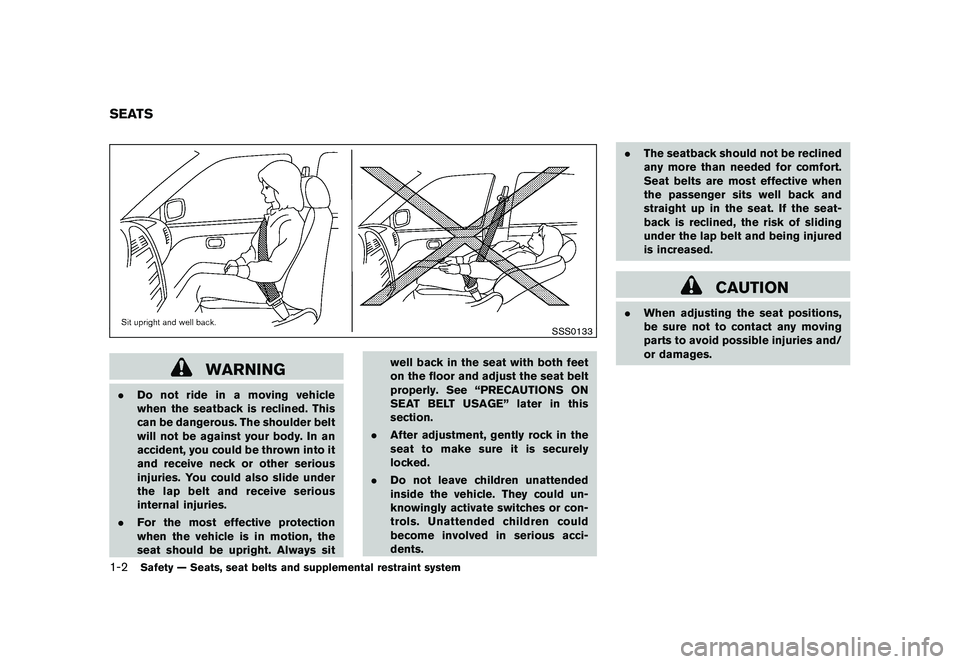
Black plate (20,1)
Model "Z34-D" EDITED: 2009/ 9/ 10
SSS0133
WARNING
.Do not ride in a moving vehicle
when the seatback is reclined. This
can be dangerous. The shoulder belt
will not be against your body. In an
accident, you could be thrown into it
and receive neck or other serious
injuries. You could also slide under
the lap belt and receive serious
internal injuries.
. For the most effective protection
when the vehicle is in motion, the
seat should be upright. Always sit well back in the seat with both feet
on the floor and adjust the seat belt
properly. See “PRECAUTIONS ON
SEAT BELT USAGE” later in this
section.
. After adjustment, gently rock in the
seat to make sure it is securely
locked.
. Do not leave children unattended
inside the vehicle. They could un-
knowingly activate switches or con-
trols. Unattended children could
become involved in serious acci-
dents. .
The seatback should not be reclined
any more than needed for comfort.
Seat belts are most effective when
the passenger sits well back and
straight up in the seat. If the seat-
back is reclined, the risk of sliding
under the lap belt and being injured
is increased.
CAUTION
.When adjusting the seat positions,
be sure not to contact any moving
parts to avoid possible injuries and/
or damages.
SEATS1-2
Safety — Seats, seat belts and supplemental restraint system
Page 23 of 409
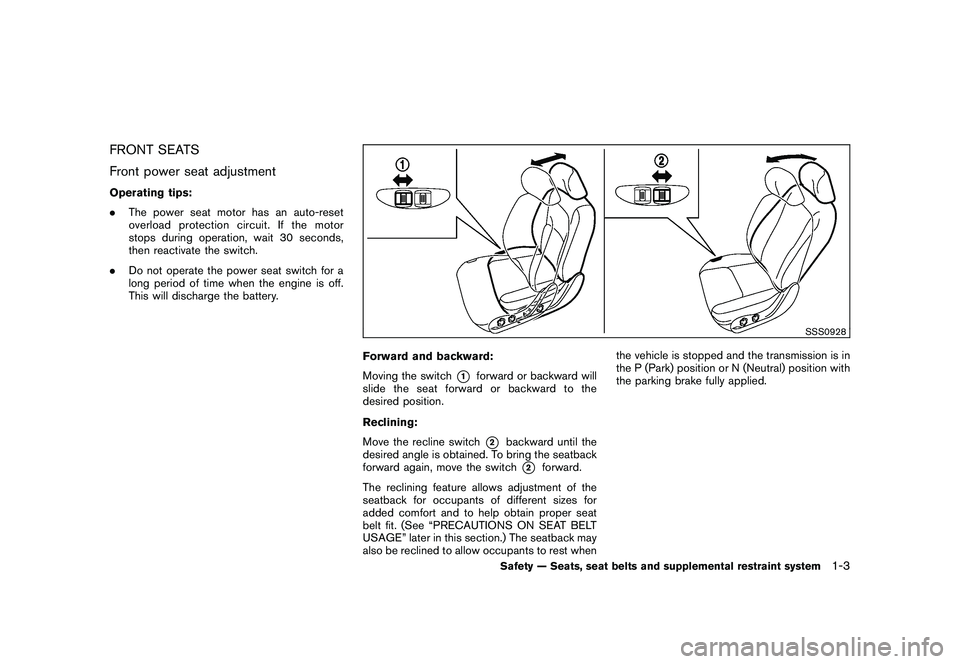
Black plate (21,1)
Model "Z34-D" EDITED: 2009/ 9/ 10
FRONT SEATS
Front power seat adjustmentOperating tips:
.The power seat motor has an auto-reset
overload protection circuit. If the motor
stops during operation, wait 30 seconds,
then reactivate the switch.
. Do not operate the power seat switch for a
long period of time when the engine is off.
This will discharge the battery.
SSS0928
Forward and backward:
Moving the switch
*1
forward or backward will
slide the seat forward or backward to the
desired position.
Reclining:
Move the recline switch*2
backward until the
desired angle is obtained. To bring the seatback
forward again, move the switch
*2
forward.
The reclining feature allows adjustment of the
seatback for occupants of different sizes for
added comfort and to help obtain proper seat
belt fit. (See “PRECAUTIONS ON SEAT BELT
USAGE” later in this section.) The seatback may
also be reclined to allow occupants to rest when the vehicle is stopped and the transmission is in
the P (Park) position or N (Neutral) position with
the parking brake fully applied.
Safety — Seats, seat belts and supplemental restraint system
1-3
Page 24 of 409
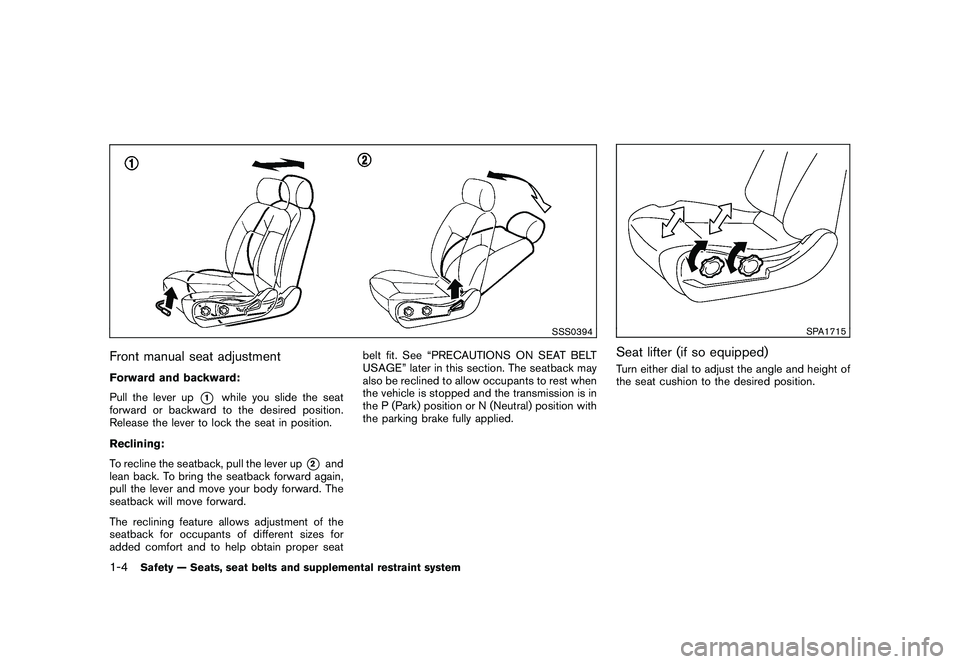
Black plate (22,1)
Model "Z34-D" EDITED: 2009/ 9/ 10
SSS0394
Front manual seat adjustmentForward and backward:
Pull the lever up
*1
while you slide the seat
forward or backward to the desired position.
Release the lever to lock the seat in position.
Reclining:
To recline the seatback, pull the lever up
*2
and
lean back. To bring the seatback forward again,
pull the lever and move your body forward. The
seatback will move forward.
The reclining feature allows adjustment of the
seatback for occupants of different sizes for
added comfort and to help obtain proper seat belt fit. See “PRECAUTIONS ON SEAT BELT
USAGE” later in this section. The seatback may
also be reclined to allow occupants to rest when
the vehicle is stopped and the transmission is in
the P (Park) position or N (Neutral) position with
the parking brake fully applied.
SPA1715
Seat lifter (if so equipped)Turn either dial to adjust the angle and height of
the seat cushion to the desired position.
1-4
Safety — Seats, seat belts and supplemental restraint system
Page 25 of 409
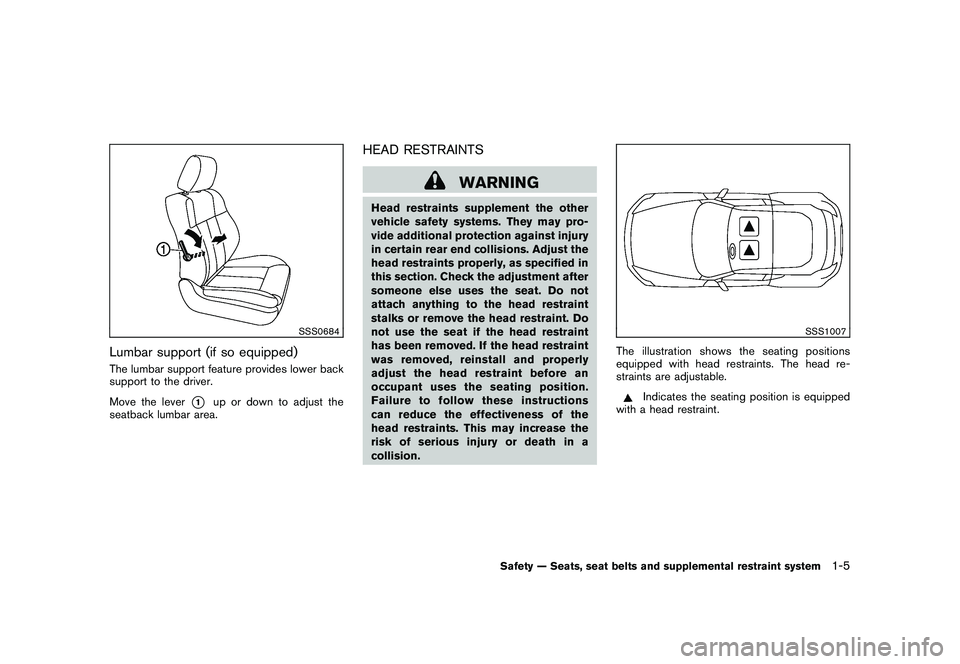
Black plate (23,1)
Model "Z34-D" EDITED: 2009/ 9/ 10
SSS0684
Lumbar support (if so equipped)The lumbar support feature provides lower back
support to the driver.
Move the lever
*1
up or down to adjust the
seatback lumbar area.
HEAD RESTRAINTS
WARNING
Head restraints supplement the other
vehicle safety systems. They may pro-
vide additional protection against injury
in certain rear end collisions. Adjust the
head restraints properly, as specified in
this section. Check the adjustment after
someone else uses the seat. Do not
attach anything to the head restraint
stalks or remove the head restraint. Do
not use the seat if the head restraint
has been removed. If the head restraint
was removed, reinstall and properly
adjust the head restraint before an
occupant uses the seating position.
Failure to follow these instructions
can reduce the effectiveness of the
head restraints. This may increase the
risk of serious injury or death in a
collision.
SSS1007
The illustration shows the seating positions
equipped with head restraints. The head re-
straints are adjustable.
Indicates the seating position is equipped
with a head restraint.
Safety — Seats, seat belts and supplemental restraint system
1-5
Page 26 of 409
Black plate (24,1)
Model "Z34-D" EDITED: 2009/ 9/ 10
SSS0992
Components1. Head restraint
2. Adjustment notches
3. Lock knob
4. Stalks
SSS0997
AdjustmentAdjust the head restraint so the center is level
with the center of your ears.
SSS0993
To raise the head restraint, pull it up.
1-6
Safety — Seats, seat belts and supplemental restraint system
Page 28 of 409
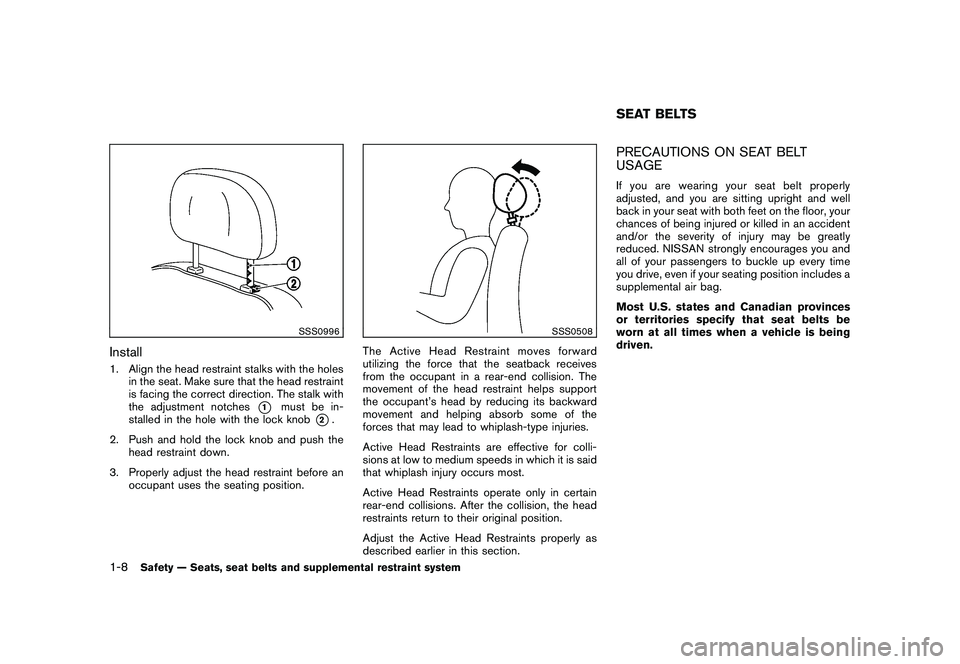
Black plate (26,1)
Model "Z34-D" EDITED: 2009/ 9/ 10
SSS0996
Install1. Align the head restraint stalks with the holesin the seat. Make sure that the head restraint
is facing the correct direction. The stalk with
the adjustment notches
*1
must be in-
stalled in the hole with the lock knob
*2.
2. Push and hold the lock knob and push the head restraint down.
3. Properly adjust the head restraint before an occupant uses the seating position.
SSS0508
The Active Head Restraint moves forward
utilizing the force that the seatback receives
from the occupant in a rear-end collision. The
movement of the head restraint helps support
the occupant’s head by reducing its backward
movement and helping absorb some of the
forces that may lead to whiplash-type injuries.
Active Head Restraints are effective for colli-
sions at low to medium speeds in which it is said
that whiplash injury occurs most.
Active Head Restraints operate only in certain
rear-end collisions. After the collision, the head
restraints return to their original position.
Adjust the Active Head Restraints properly as
described earlier in this section.
PRECAUTIONS ON SEAT BELT
USAGEIf you are wearing your seat belt properly
adjusted, and you are sitting upright and well
back in your seat with both feet on the floor, your
chances of being injured or killed in an accident
and/or the severity of injury may be greatly
reduced. NISSAN strongly encourages you and
all of your passengers to buckle up every time
you drive, even if your seating position includes a
supplemental air bag.
Most U.S. states and Canadian provinces
or territories specify that seat belts be
worn at all times when a vehicle is being
driven.SEAT BELTS
1-8
Safety — Seats, seat belts and supplemental restraint system
Page 38 of 409
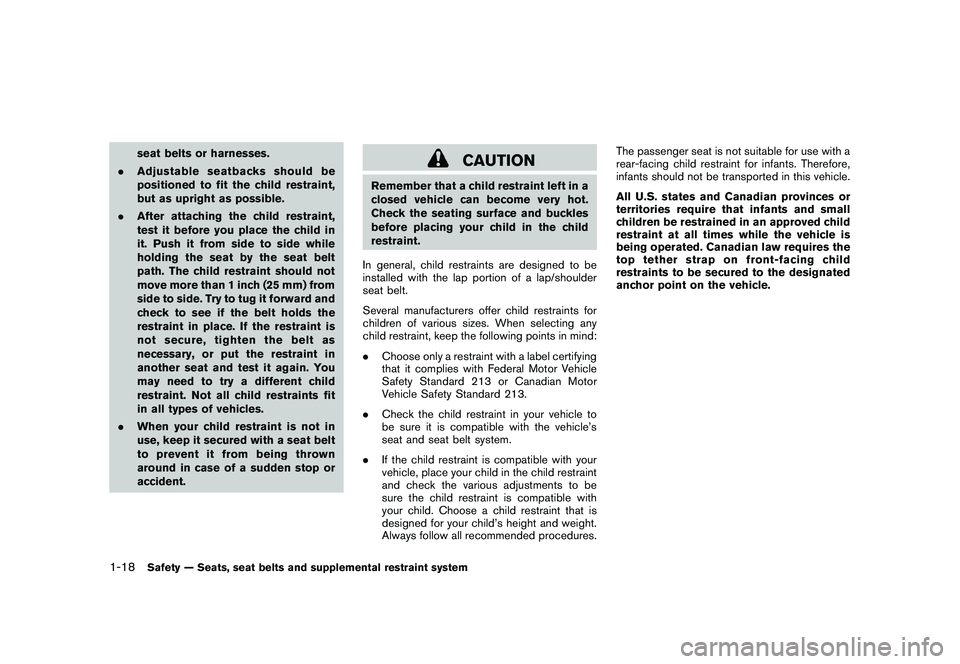
Black plate (36,1)
Model "Z34-D" EDITED: 2009/ 9/ 10
seat belts or harnesses.
. Adjustable seatbacks should be
positioned to fit the child restraint,
but as upright as possible.
. After attaching the child restraint,
test it before you place the child in
it. Push it from side to side while
holding the seat by the seat belt
path. The child restraint should not
move more than 1 inch (25 mm) from
side to side. Try to tug it forward and
check to see if the belt holds the
restraint in place. If the restraint is
not secure, tighten the belt as
necessary, or put the restraint in
another seat and test it again. You
may need to try a different child
restraint. Not all child restraints fit
in all types of vehicles.
. When your child restraint is not in
use, keep it secured with a seat belt
to prevent it from being thrown
around in case of a sudden stop or
accident.
CAUTION
Remember that a child restraint left in a
closed vehicle can become very hot.
Check the seating surface and buckles
before placing your child in the child
restraint.
In general, child restraints are designed to be
installed with the lap portion of a lap/shoulder
seat belt.
Several manufacturers offer child restraints for
children of various sizes. When selecting any
child restraint, keep the following points in mind:
. Choose only a restraint with a label certifying
that it complies with Federal Motor Vehicle
Safety Standard 213 or Canadian Motor
Vehicle Safety Standard 213.
. Check the child restraint in your vehicle to
be sure it is compatible with the vehicle’s
seat and seat belt system.
. If the child restraint is compatible with your
vehicle, place your child in the child restraint
and check the various adjustments to be
sure the child restraint is compatible with
your child. Choose a child restraint that is
designed for your child’s height and weight.
Always follow all recommended procedures. The passenger seat is not suitable for use with a
rear-facing child restraint for infants. Therefore,
infants should not be transported in this vehicle.
All U.S. states and Canadian provinces or
territories require that infants and small
children be restrained in an approved child
restraint at all times while the vehicle is
being operated. Canadian law requires the
top tether strap on front-facing child
restraints to be secured to the designated
anchor point on the vehicle.
1-18
Safety — Seats, seat belts and supplemental restraint system